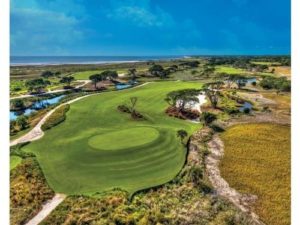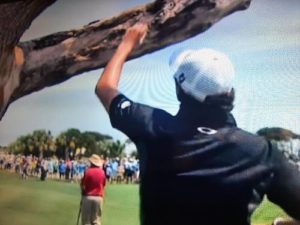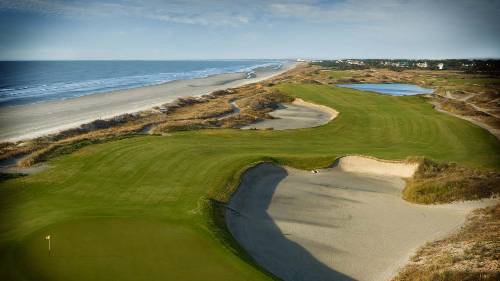
KIAWAH ISLAND, S.C. – Dappled sunshine off the lapping ocean waves or a howling gale bending flagsticks to their near-breaking point? Which Kiawah Island Ocean Course will we see for the 2021 PGA Championship? The windless one that surrendered a winning score of 22-under to Colin Montgomerie at the 1997 World Cup (and Alex Cejka and Per-Ulrik Johansson shot 63 and 64 respectively)? Or the gale-buffeted Ocean Course of the 2012 PGA Championship’s second round, where the scoring average was a bloody 78.1, the highest single-day total in the tournament’s history?
“[That] was the hardest day on the course I’ve ever had to play in,” confided an exhausted Keegan Bradley, defending his title at the time and calling his 5-over 77 a “solid round” in the maelstrom.
We know for certain that as goes the wind, so go the scores at the Ocean Course. If the wind blows, we’ll see a British Open in May and level par will be worth diamonds. If not, we may see the tour pros play lawn darts and cover the scoreboard in red numbers.
However, for the first time since the Ocean Course opened in 1991 for the Ryder Cup’s infamous “War by the Shore,” the world’s greatest players will face the course in May, and that means a totally different prevailing wind. In summer and fall the afternoon wind ordinarily comes out of the southwest. Not so in May, when cold fronts still occasionally come roaring though from the northeast or north and temperatures are significantly cooler than August.
With that in mind, let’s take a closer look at the holes at the Ocean Course that should offer the wildest swings on the scoreboard, those “half-par holes” as we call them in the vernacular, holes that play much harder or easier than they say on the scorecard and therefore are more prone to swings of fortune than routine pars.

QUICK STATS
KIAWAH ISLAND OCEAN COURSE, KIAWAH ISLAND, S.C.
Par 36-36=72, 7,876 Yards, Slope 144, Rating 77.2
1st Hole – par-4, 400 yards.
Kiawah’s Ocean course is designed in a figure-eight so as to have 1) a roughly equal number of holes playing in the same direction; 2) players face an equal number of left-to-right wind patterns as right-to-left; and 3) a roughly equal number of shots to be shaped either way.
Holes one through five all play in an easterly direction and afford the golfer a chance to get off to a fast start. The short par-4 should be merely a drive and a chip for long hitters such as Bryson Dechambeau and Dustin Johnson as its straightaway with no trees to worry about.
2nd Hole – par-5, 557 yards.
All the par-5s at the Ocean Course are reachable in two shots, wind and weather permitting. Standing atop the tee box, the course’s furthest point from the Atlantic Ocean, it’s a long carry over as much of the salt marsh as the player dares bite off. The approach is played to a light bulb-shaped green set between two sandy ridges that will accept a long running approach. The two tiered green is really two tiny greens in one.
3rd Hole – par-4, 380 yards.


The shortest par-4 on the course may also be the sexiest. The greatest golf course architects can say more in 350 yards than a milquetoast designer can say in 480. From the tee box the greens beckons to you atop its hillock, falling away on all sides. But a huge, gnarled, wind-scorched oak tree blocks the way, as do several cypress trees at the edge of a deep waste bunker. On his way to a record-shattering eight-shot victory in the 2012 PGA Championship, Rory McIlroy saved par after hitting his ball into a hole in the tree and taking a penalty stroke.
7th Hole – par-5, 580 yards
At the sixth tee the golfer turns around and plays the next eight consecutive holes in a westerly direction.
“It was so bad out there, I could have blown up at any time. It’s blowing like a British Open,” continued Keegan Bradley, still a bit shell-shocked at what he endured during the second round at the 2012 PGA. “7-13 are as hard a stretch of golf as there is in the world.”
Depending on the wind, at the par-5 seventh, the players should be calling for a steak knife and a bib, instead of Mommy or Aunt Pat as Bradley seemed to be doing. On a benign day or with a following wind, perhaps like we might see in May, the hole could be among the easiest on the course. Another diagonal tee shot leaves the golfer with a straightforward approach to another two tiered green that is wide open in front.
10th Hole – par-4, 447 yards.
In 2012, five of the Ocean Course’s six hardest holes came on the back nine, and four of those come in the final six holes, so Kiawah definitely gets stronger as the round progresses. Indeed, the entire back nine played to a bloated 37.7 stroke average for the week: one and three-quarters strokes over par. By contrast, the front played to 36.9, three-quarters of a stroke easier.
10 green is a terrific place to watch the action for two reasons: first the spectators get long views down the 11th and 17th holes as well and, second, the 10th gave golfers fits in 2012. Â It’s a mere 447 yards – a drive and a pitch nowadays for these strapping young lions – but the green is set obliquely, down in a dell guarded by a sinister sinkhole of a back bunker and a nasty, deep trench bunker on the left.
I know Pete (and Alice) wasn’t thinking about this, (because he told me so), but with the spectators ringing the hole and green site and with the green set below in the dell, the hole reminds me of Royal Birkdale.
12th Hole – par-4, 410 yards.
The first of two holes flanked by the canal along the right, set-up maven Kerry Haigh is expected to move the tees up to a mere 300 yards to tempt the golfers into trying to drive the green. It’s the widest fairway on the course, but it narrows into the most supermodel slim approach. Also, the further down the fairway the ball lands, the more downhill the lie for the approach shot. Anything right is dead as Jeffrey Epstein, so it’s either an eagle two (a la Collin Morikawa) or double bogey six for anyone brave or foolish enough to try hitting driver. There is a small collar of rough on the left hand side that may see action from the longer hitters.
13th Hole – par-4, 497 yards.
The last of the westerly holes also played the toughest on the course for the entire week in 2012, an eye-popping 4.38 strokes. Again running the length of the canal, and daring the golfer to challenge as much of the hazard as he dares, pot bunkers pinch the left side of the fairway while deep sandy wastes and washes guard the greenside on the left.
14th Hole – par-3, 240 yards.

Pete Dye loved North Berwick in Scotland, and he tried to build legitimate, authentic Redan holes, complete with greens running away from the player, wherever he was able to convince the money to let him do it. Although this hole is overshadowed by 17, its far more frightening and penal sister, it actually played harder in 2012 than 17 did, fourth hardest on the golf course versus sixth hardest for 17. (And a 3.33 stroke average vs. 17’s 3.30). The golfer faces a fistfight for a three. For openers 240 yards is particularly long for a Redan, far longer than the usual 175-210 yards. Worse still, the green sits high on a windblown hillock and falls off on all sides. Finally, the Redan bunker is one so enormous, deep, and geometrically-shaped that it looks like Pete Dye was cribbing notes off Charles Blair Macdonald, Seth Raynor, or Charles “Steamshovel” Banks’s paper.
17th Hole – par-3, 223 yards.

This iconic par-3 belongs in any discussion of the greatest holes in American golf. A criminally narrow green feels even smaller shoehorned between the water and two deep bunkers. Play it even par for the championship, and you’ll be grateful. The most recognizable moment in its history is also its most horrifying: Mark Calcavecchia, in the midst of choking away a 4-up with four holes to play lead (and perhaps the 1991 Ryder Cup with it) actually topped an iron into the water like a 20-handicap duffer with the entire golf world watching. Â His opponent, Colin Montgomerie won the hole with a double bogey five as opposed to Calc’s quad seven. Calc was saved from a lifetime of infamy when Germany’s Bernhard Langer, a two-time Masters winner, missed a six-foot putt and lost his match and the Cup to Hale Irwin and the American team.
NEWS, NOTES, AND QUOTES
How about that? We got Per-Ulrik Johansson in an article. When was the last time you heard Per-Ulrik Johansson’s name? Hamlet perhaps? Alas...Per-Ulrik…I knew him Horatio…a fellow of infinite jest and excellent fancy…





